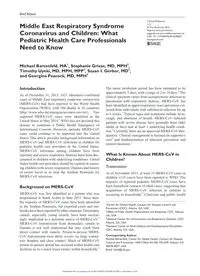
2017 Middle East Respiratory Syndrome Coronavirus and Children PDF
Preview 2017 Middle East Respiratory Syndrome Coronavirus and Children
Clinical Pediatrics 1–3 © The Author(s) 2016 Reprints and permissions: sagepub.com/journalsPermissions.nav DOI: 10.1177/0009922816678820 cpj.sagepub.com Brief Report Introduction As of December 31, 2015, 1621 laboratory-confirmed cases of Middle East respiratory syndrome coronavirus (MERS-CoV) had been reported to the World Health Organization (WHO), with 584 deaths in 26 countries (http://www.who.int/emergencies/mers-cov/en/). Two imported MERS-CoV cases were identified in the United States in May 2014.1 WHO has not declared this disease to constitute a Public Health Emergency of International Concern. However, sporadic MERS-CoV cases could continue to be imported into the United States. This article provides background information on MERS-CoV and MERS-CoV infections in children for pediatric health care providers in the United States. MERS-CoV infections among children have been reported, and severe respiratory illnesses have been doc- umented in children with underlying conditions. United States health care providers should be vigilant in assess- ing children with severe respiratory illnesses and history of recent travel in or near the Arabian Peninsula for MERS-CoV infections. Background on MERS-CoV MERS-CoV was first identified in a patient who was hospitalized in Saudi Arabia in June 2012. Since then, the majority of MERS-CoV cases have been identified in the Arabian Peninsula, but exported cases and out- breaks have been reported by other countries. Dromedary camels, especially young camels, have been increas- ingly implicated as a potential source of MERS-CoV.2 MERS-CoV transmission from dromedary camels to humans is not well understood but may result from direct contact with camels. Person-to-person MERS- CoV transmission most likely occurs via large respira- tory droplets and close contact. Much of MERS-CoV person-to-person spread has occurred within health care facilities or, to a much lesser extent, within households.3 The mean incubation period has been estimated to be approximately 5 days, with a range of 2 to 14 days.4 The clinical spectrum varies from asymptomatic infection to pneumonia with respiratory distress. MERS-CoV has been identified in upper-respiratory-tract specimens col- lected from individuals with subclinical infection for up to 6 weeks.5 Typical signs and symptoms include fever, cough, and shortness of breath. MERS-CoV–infected patients with severe disease have generally been older adults or have had at least 1 underlying health condi- tion.4 Currently, there are no approved MERS-CoV ther- apeutics. Clinical management is focused on supportive care6 and implementation of infection prevention and control measures.7 What Is Known About MERS-CoV in Children? Transmission As of November 2015, at least 35 MERS-CoV cases in children (≤18 years) have been reported to WHO. The majority of reported pediatric MERS-CoV cases have been household contacts of adult cases, suggesting that acquisition of MERS-CoV infection in children is occurring in households.8 Clinicians and public health 678820 CPJXXX10.1177/0009922816678820Clinical PediatricsBartenfeld et al brief-report2016 1Center for Global Health, Centers for Disease Control and Prevention (CDC), Atlanta, GA, USA 2Office of Public Health Preparedness and Response, CDC, Atlanta, GA, USA 3National Center for Immunization and Respiratory Diseases, CDC, Atlanta, GA, USA 4National Center on Birth Defects and Developmental Disabilities, CDC, Atlanta, GA, USA Corresponding Author: Michael Bartenfeld, Center for Global Health, Centers for Disease Control and Prevention, 1600 Clifton Rd NE, MS-D69, Atlanta, GA 30329-4027, USA. Email:
